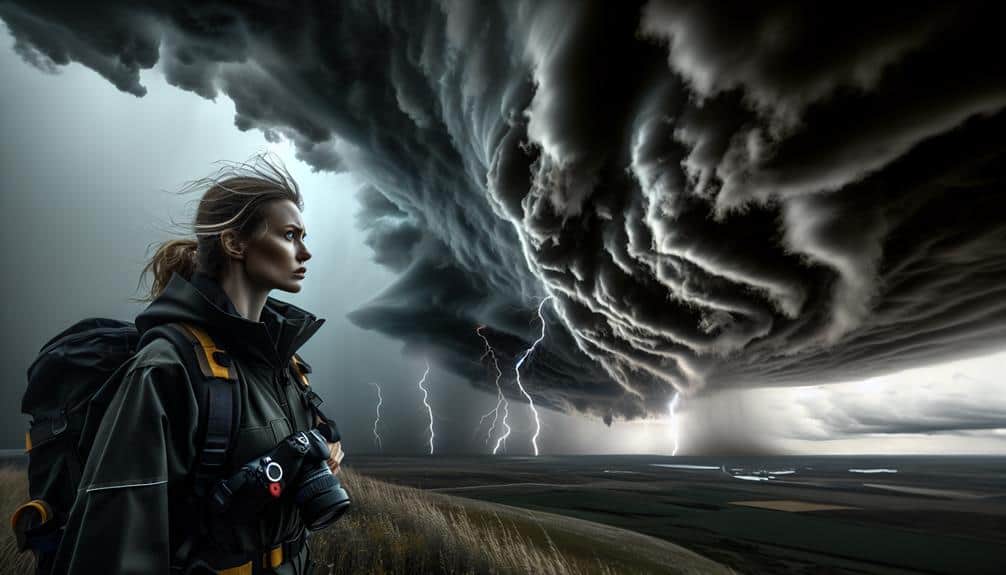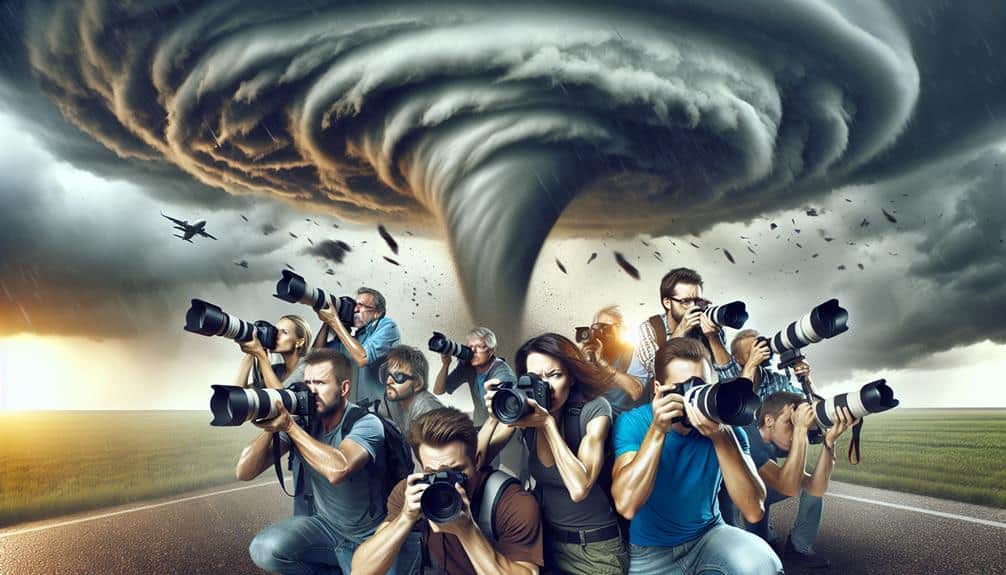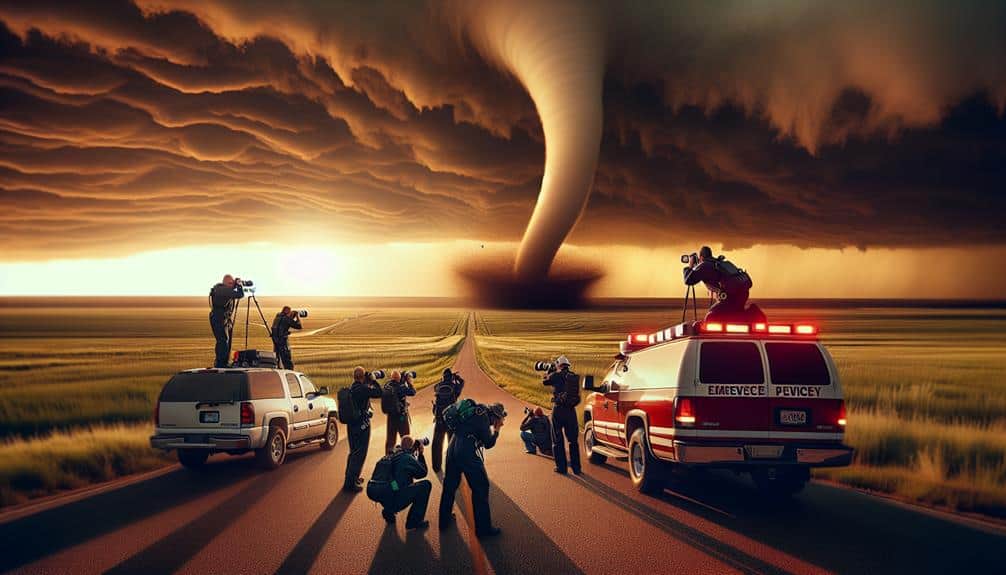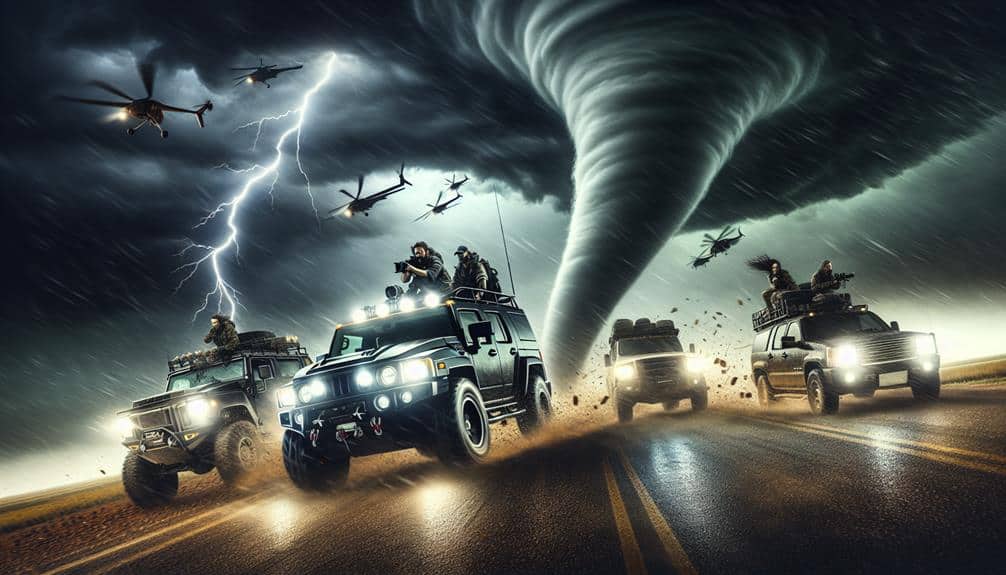We prioritize storm chasers' safety during coverage to minimize risks and guarantee effective data collection in extreme weather. By adhering to safety protocols, equipping with specialized gear, and undergoing rigorous training, we reduce potential threats. Coordination with emergency services and utilizing advanced communication tools enhance our response capabilities. In addition, addressing the psychological impact through evidence-based support and continuous monitoring is essential to maintaining mental health. Prioritizing safety doesn't just protect lives—it ensures the integrity of storm data and improves public trust in our reporting. Learn more about these measures and their impact on storm-chasing protocols.
Key Points
- Ensuring storm chasers' safety minimizes injury risks and fatalities during coverage.
- Safe storm chasing practices maintain the integrity and functionality of essential equipment and gear.
- Effective safety protocols enhance coordination and real-time communication with emergency services.
- Prioritizing safety allows storm chasers to provide accurate, timely, and credible information to the public.
Importance of Safety Protocols
Adhering to strict safety protocols is necessary to minimizing risks and guaranteeing storm chasers' well-being during extreme weather events. By following established safety guidelines, we can systematically reduce the hazards associated with storm chasing. This involves a thorough risk assessment process that helps identify potential threats in advance. By understanding the severity and likelihood of these threats, we can devise effective prevention strategies.
Accountability plays a pivotal role in maintaining these safety protocols. Each team member must be responsible for adhering to these guidelines, making sure that everyone is aware of their role in maintaining collective safety. Utilizing data-driven approaches, we can evaluate past incidents and refine our methods to mitigate risks more effectively.
Risk assessment and prevention are crucial in this high-stakes environment. We employ meteorological data, predictive models, and real-time monitoring to anticipate dangerous conditions. These tools enable us to make informed decisions and take proactive measures to avoid perilous situations.
Equipment and Gear Essentials
To make sure we adhere to strict safety protocols, we must equip ourselves with the right tools and gear designed to withstand extreme weather conditions. Our primary focus should be on maintaining the integrity and functionality of our gear. Without proper gear maintenance, our equipment could fail at critical moments, endangering our lives and compromising our mission.
Effective communication devices are paramount. We rely on high-frequency radios and satellite phones to stay in constant contact with our team and emergency response units. These devices must be waterproof and impact-resistant, ensuring they function even in the harshest environments.
Our vehicles need to be fortified with reinforced exteriors and specialized tires to navigate treacherous terrains. Anemometers and barometers are essential for real-time weather data, while GPS systems guarantee we can track our exact location.
Personal protective equipment, including helmets, goggles, and weather-resistant clothing, minimizes injury risks from flying debris.
Adhering to safety protocols isn't just about having the right gear; it's about ensuring every piece is in prime condition. Regular gear maintenance checks and routine drills enhance our preparedness.
Training for Extreme Conditions
How can we effectively prepare for the unpredictable and often perilous conditions encountered during storm chasing?
To start, we need to build physical endurance and mental focus. Rigorous physical training is essential; it guarantees we can withstand long hours, extreme weather, and rapid movements. Mental focus, on the other hand, is vital for making quick, accurate decisions under pressure. Cognitive exercises and simulations of storm scenarios can help build this resilience.
Survival skills are another pillar of preparation. We must be adept at first aid, know how to find or create shelter, and understand the basics of navigation without electronic aids. These skills could be the difference between life and death in remote locations where help may not be immediately available.
Communication strategies play an important role in our safety. Mastery of radio communications, knowledge of signal protocols, and the ability to relay concise, accurate information can enhance coordination within the team and with external entities. We should practice these skills in varied conditions to guarantee reliability.
Coordination With Emergency Services
Effective coordination with emergency services is vital for storm chasers to guarantee swift response and resource allocation during severe weather events. Our ability to communicate efficiently with emergency responders can greatly impact the safety and success of our operations.
Developing robust communication strategies is essential. We depend on real-time data exchange through advanced technologies like GPS tracking, satellite communications, and mobile networks. These tools help us relay critical information about storm paths, intensity, and potential hazards to emergency services, enabling them to respond promptly and allocate resources effectively.
Emergency response coordination involves pre-established protocols that allow us to work seamlessly with local authorities. We conduct joint training exercises and simulations to familiarize ourselves with each other's operational procedures. This mutual understanding enhances our collective ability to manage emergencies, minimizing risks to both storm chasers and the general public.
Furthermore, having a direct line of communication with emergency services allows us to receive timely updates and directives, enabling us to adjust our positions and strategies dynamically. This level of coordination not only maximizes our safety but also ensures we provide accurate and actionable information to meteorologists and emergency planners.
Through these efforts, we contribute to a more resilient and informed community.
Psychological Preparedness

As storm chasers, we must acknowledge the significant impact of sustained high-stress environments on our mental health. Implementing evidence-based stress management techniques, such as cognitive-behavioral strategies and mindfulness practices, can mitigate these effects.
Mental Health Impact
Often overlooked, the psychological readiness of storm chasers is crucial for mitigating the mental health impacts of their high-risk profession. Our work exposes us to extreme and often traumatic events, which can lead to significant psychological stress. To effectively manage these challenges, we need to establish robust support systems and access professional trauma counseling.
A holistic approach to psychological readiness includes:
- Support Network: Building a strong support network among peers can provide essential emotional backing and practical advice during and after storm-chasing events.
- Trauma Counseling: Regular sessions with trauma counselors can help us process traumatic experiences, reducing the risk of long-term psychological issues such as PTSD.
- Education on Psychological Effects: Training programs that educate storm chasers about the potential psychological impacts of their work can enhance awareness and preparedness.
- Monitoring and Assessment: Implementing continuous mental health monitoring and assessments can help identify signs of distress early, allowing for timely intervention.
Stress Management Techniques
To manage stress effectively, storm chasers must integrate evidence-based techniques such as mindfulness practices, cognitive-behavioral strategies, and biofeedback into their daily routines. Mindfulness practices, including meditation and deep breathing exercises, help us maintain a state of calm and focus during high-pressure situations. By dedicating 10-15 minutes daily to these practices, we can notably reduce cortisol levels, enhancing our psychological preparedness.
Incorporating cognitive-behavioral strategies into our self-care practices allows us to reframe negative thoughts and develop resilient coping strategies. Techniques such as cognitive restructuring can help us challenge irrational fears and maintain a balanced perspective, even when facing the unpredictability of severe weather events.
Biofeedback provides us with real-time data on physiological responses to stress, enabling more effective self-regulation. Utilizing devices that measure heart rate variability, we can adjust our breathing patterns and muscle tension, promoting a state of relaxation.
Impact on Public Perception
When we prioritize storm chasers' safety, we must consider how media responsibility standards influence public perception. Accurate and responsible reporting builds trust in the information disseminated during severe weather events.
As researchers, we must guarantee that safety protocols aren't only implemented but also transparently communicated to maintain public trust in storm chasers' reports.
Media Responsibility Standards
As stakeholders in the dissemination of information, we must uphold strict media responsibility standards to mitigate the risk of sensationalism, which can significantly alter public perception and endanger storm chasers' safety. Upholding ethics and accountability is crucial in media coverage, especially when dealing with natural disasters. The portrayal of storm chasing can influence public behavior and risk-taking, potentially leading to hazardous situations.
To maintain the highest standards of media responsibility, we should adhere to the following guidelines:
- Accuracy: Guarantee all information reported is based on verifiable data and scientific evidence.
- Contextualization: Provide context to the information presented, avoiding exaggerated claims that could lead to unnecessary panic or risky behavior.
- Transparency: Clearly communicate the sources of the data and the methodologies used in their collection.
- Safety Precautions: Emphasize the importance of safety measures and protocols for storm chasers to prevent avoidable accidents.
Trust in Reporting
Building trust in reporting is essential for accurately shaping public perception and guaranteeing informed decision-making during severe weather events. When we prioritize ethical reporting, we enhance our credibility, which in turn empowers individuals to make critical choices about their safety. By adhering to rigorous standards, we provide the public with reliable, data-driven information that they can depend on.
This credibility building is crucial; it not only prevents misinformation but also fosters a well-informed community ready to respond effectively to weather threats.
Storm chasers play a vital role in gathering real-time data, but their safety mustn't be compromised for sensational coverage. When we prioritize their well-being, we reinforce our commitment to ethical reporting. This approach minimizes risks and guarantees the continuity of accurate, live updates. By doing so, we maintain the integrity of our reports, which is crucial for public trust.
In an era where misinformation can spread rapidly, our dedication to ethical reporting and credibility building becomes even more essential. As we remain steadfast in these principles, we help preserve the public's freedom to make informed, autonomous decisions based on trustworthy information.
Frequently Asked Questions
How Do Storm Chasers Stay Informed About Changing Weather Conditions in Real-Time?
With a finger on the pulse of the storm, we utilize real-time weather alerts and GPS tracking to stay informed. This guarantees we can adapt swiftly to changing conditions, maximizing our freedom to chase safely and effectively.
We've heard personal reflections from storm chasers about near-miss incidents. They emphasized safety precautions like real-time radar updates and GPS tracking, ensuring split-second decisions. Their stories highlight the balance between data collection and personal freedom in the field.
Are There Specific Regions Where Storm Chasing Is More Dangerous?
In the eye of the storm, regions like Tornado Alley present amplified risk factors. We mitigate these with strict safety protocols and precautions, relying on data-driven methods to navigate the tempest while ensuring our freedom to chase safely.
How Do Storm Chasers Manage Their Mental Health Post-Coverage?
We manage our mental health post-coverage through structured support networks and evidence-based coping strategies. Prioritizing self-care, we utilize techniques such as cognitive-behavioral therapy and mindfulness to mitigate stress and maintain psychological well-being.
What Are the Ethical Considerations When Broadcasting Live Storm Footage?
When broadcasting live storm footage, we must balance professional responsibilities and privacy concerns. We should consider viewer impact, guarantee accurate data dissemination, and coordinate with emergency response teams to avoid hindering their operations. Ethical broadcasting is essential.


